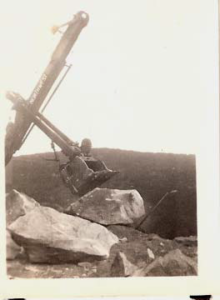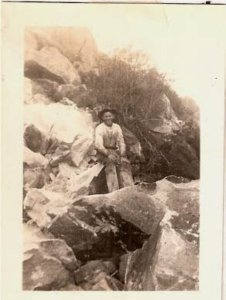The original road to Crest was barely passable. In September 1927, W.S. Jenkins was empowered to procure a sign to be placed at the foot of the grade warning all persons that the road was private property, to use the road at their own risk, and warning folks against heavy loads on the road. Sometimes residents got near the top of the hill on the winding dirt road and had to back up the road when gas wouldn’t reach the carburetor when going forward. Due to the challenging road, the people who lived up here would get their picks and shovels and go down and do the repair work on the road when necessary.
The La Cresta Grade - 1928
 It wasn’t long until people owning property decided that this was a nice location for a full time residence and these full time residents soon petitioned the county to furnish them with a “decent” road. It was a focus of both Suncrest and the La Cresta Community centers that wrote about the needed improvement to the Suncrest grade. The county engineers found the best answer to that problem was to put in a completely new road in what was known at that time as Forester Creek Canyon.
It wasn’t long until people owning property decided that this was a nice location for a full time residence and these full time residents soon petitioned the county to furnish them with a “decent” road. It was a focus of both Suncrest and the La Cresta Community centers that wrote about the needed improvement to the Suncrest grade. The county engineers found the best answer to that problem was to put in a completely new road in what was known at that time as Forester Creek Canyon.
When completed, the caretaker was instructed to place a sign at the foot of the old Suncrest grade so that it directed traffic toward the new La Cresta grade; another sign was to be placed at the foot of the new grade so that traffic coming from the old grade could see it as well as traffic from the highway.
 The La Cresta Road was built in 1928. Even after being built, the La Cresta Road was a narrow, arduous road. Stanley Douglas wrote, “The Crest Road was called the ‘Heinz Grade’ because of 57 varieties of curves. There was a very large boulder at every curve. Speed was 15 mph. The road was very narrow – about 1 ½ cars wide with lots of chuck holes.”
The La Cresta Road was built in 1928. Even after being built, the La Cresta Road was a narrow, arduous road. Stanley Douglas wrote, “The Crest Road was called the ‘Heinz Grade’ because of 57 varieties of curves. There was a very large boulder at every curve. Speed was 15 mph. The road was very narrow – about 1 ½ cars wide with lots of chuck holes.”
Improvements to the Grade
Minutes from a Suncrest, Inc. meeting dated July 23, 1929 stated, “A new Suncrest high gear road (the La Cresta road), 20 feet wide costing $30,000 will be completed October 29, 1929.” In 1930 the WPA did indeed widen the road. The funding for this project was approximately $21,000. The county road department oiled the road in 1933 and ever since that time the County has maintained it.
Naming the grade proved a challenge since a rivalry existed between Suncrest and La Cresta. Articles appearing in the local papers in 1929 and 1934 report on this road controversy. The official name as listed on county records for this road was “Highway No. 439.” Supervisor Aul sought to split the difference by reverting to the original name which was Forester Canyon. However, none approved. Residents of La Cresta called it the “La Cresta Road;” and the Suncrest folk continued to call it the “Suncrest Road.” The only sufferer was the mail carrier on the route who had to contend with two “Suncrest Roads” on his rural delivery route.
In 1962, the Crest Civic Group was working with the county supervisor to improve the roads in Suncrest. There was also a major widening and repaving of the La Cresta Road which was dedicated in 1966. A local paper reported the event and showed Kathy Reynolds, age 14, as queen of the event.
Straightening of the Crest Grade – 1970
In 1970, a committee approached the Road Commissioner regarding straightening the La Cresta grade and filling the chuck holes. They were informed that the allotment of money for the district was already spoken for. Stan Douglas recalled, “We contacted Supervisor Bird, but his hands were tied. The following year he did add us on the agenda before they started discussing the budget. We did our homework. We gathered photos of the accidents, some of which were very gruesome, as well as photos of the chuck holes. The cars usually hit a boulder or ran over the side.
“On the day of the hearing, a transit bus that held 50 people and 5 cars holding 25 people left Crest. We bought 75 pie tins and painted them orange with the word Crest in white. We hung them around our necks with ribbons. All the pictures were rolled up. We also had pictures taken from a bi-plane. We put them together to make one big picture of the whole area. We imprinted on this picture a route that could be used. We had a road engineer that helped us out at no cost. Arriving at the meeting the group stood in the back rather than sitting. Supervisor Bird looked up and said, ‘it looks like we have a delegation from Crest. I think before we start the meeting, we will give the Crest people a chance to present their case.’ We had a retired public speaker present.
“During the meeting, as he brought up the different facts, we unrolled the pictures which were very shocking. When we showed them our air pictures and the new route imprinted on it, the board was very impressed.
“They thanked us very much for our presentation. Two hours later we received a phone call that they had allotted us three million dollars- one million a year to be used on our road for three years. The road today is two and three lanes because of these efforts.”
Streets of Suncrest and La Cresta
The Streets of Suncrest and La Cresta
The grade wasn’t the only issue having to do with the community roads. Because of the fact that the subdivision map of Suncrest was not approved by the Board of Supervisors of San Diego County, cabin sites were sold by metes and bounds; and for the same reason various streets did not become a part of the county road system. The term “metes” refers to a boundary defined by the measurement of each straight run, specified by a distance between the terminal points, and an orientation or direction. The term “bounds” refers to a more general boundary description, such as along a certain watercourse, a stone wall, an adjoining public roadway, or an existing building. The system is often used to define areas where precise definition is not required or would be far too expensive, or previously designated boundaries can be incorporated into the description.
The first successful result of an official road came when San Diego County took in Suncrest Blvd., Albatross Place, South Lane, and Crest Drive. Residents were required to bring the road into compliance at their own expense before the county would accept the road. Several years later, a community group spent $1,200 in oiling portions of Lento Lane, West Drive, and Eucalyptus Drive between South Lane and its southerly termination which the old-timers used to refer to as the “South Forty.” When this improvement had been accomplished, the Board of Supervisors was approached with a petition. After due process through the County Planning Commission, these roads were also taken into the county road system.
This explains why many Crest residents today continue to live on dirt roads. These roads are considered private roads and must be maintained by the residents of the individual streets and are not maintained by the county.
Mountain View Road - 1948-51
Mountain View Road and the Crest Civic League – 1948-1951
The road through to Harbison Canyon did not happen overnight. “That road was one of the first major civic improvements undertaken by the newly formed Crest Civic League in 1948. The road at that time only went out about a mile. Elmer Hamm was very persistent in his letter writing to the Board of Supervisors, representing Crest Civic League, Crest Country Club, and Crest Volunteer Fire Department. After many excuses and delays by the board, Mr. Hamm made the proposal to have a fire truck trail bulldozed into Harbison Canyon by the State Forestry, thus getting our foot in the door for paving in the future. In a joint effort, the county did the field surveys and the Forestry Service bulldozed. The fire trail was finally opened in August 1952. There is no information on when the county actually took over the road and paved it.”



